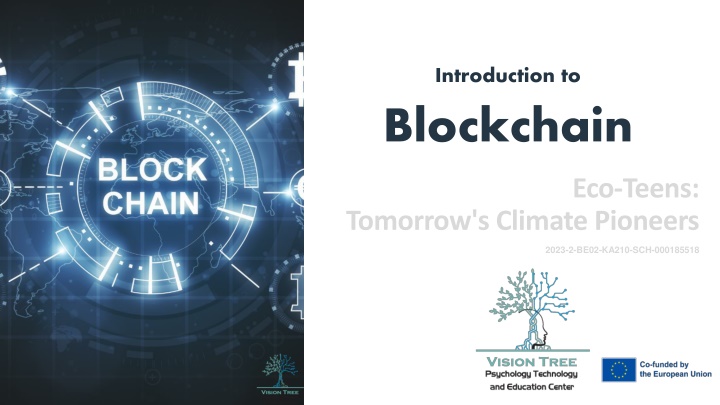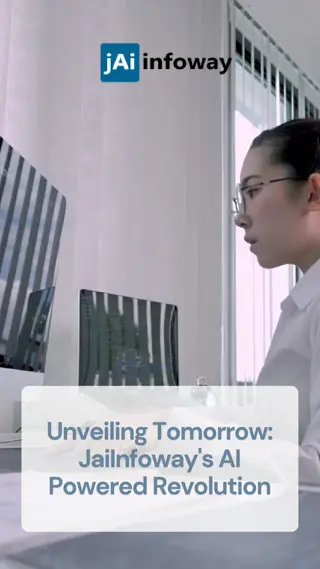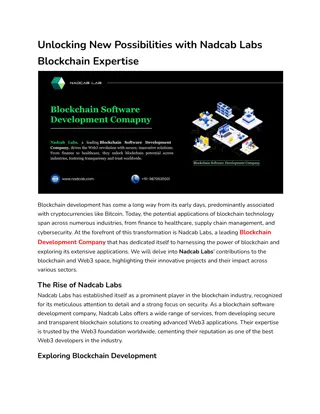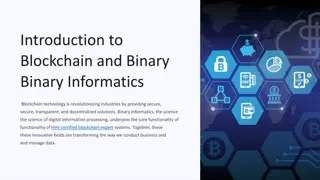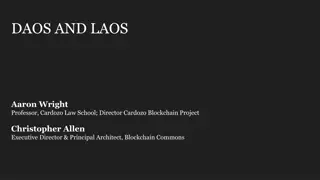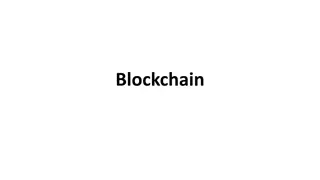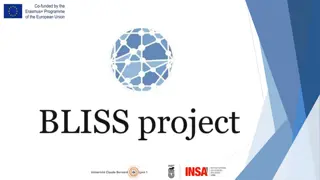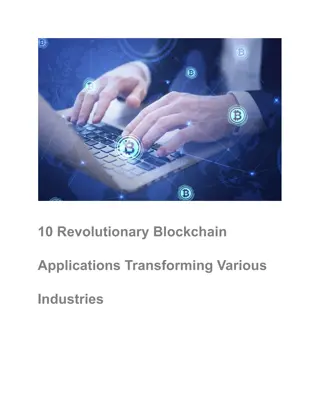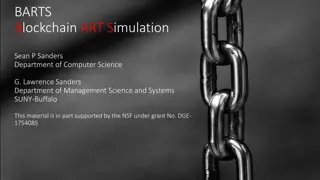Blockchain Revolution: Transforming Sectors for Tomorrow's Climate Leaders
Discover how blockchain technology is revolutionizing traditional centralized databases and trusted third-party systems in various sectors. Explore the innovative impact of blockchain on climate initiatives, addressing security risks, scalability issues, and transparency challenges. Uncover the role of decentralized networks in redefining trust and efficiency for a sustainable future.
Download Presentation

Please find below an Image/Link to download the presentation.
The content on the website is provided AS IS for your information and personal use only. It may not be sold, licensed, or shared on other websites without obtaining consent from the author.If you encounter any issues during the download, it is possible that the publisher has removed the file from their server.
You are allowed to download the files provided on this website for personal or commercial use, subject to the condition that they are used lawfully. All files are the property of their respective owners.
The content on the website is provided AS IS for your information and personal use only. It may not be sold, licensed, or shared on other websites without obtaining consent from the author.
E N D
Presentation Transcript
Introduction to Blockchain Eco-Teens: Tomorrow's Climate Pioneers 2023-2-BE02-KA210-SCH-000185518 2024 BRUSSELS/BELGIUM
The World before Blockchain 1 What is Blockchain? 2 How Blockchain Affects Sectors? 3 Blockchain s Impact on Climate 4
The World before Blockchain | Bank 1. Centralized Databases
The World before Blockchain 1. Centralized Databases 1. Centralized Databases Central Authority: A single entity (such as a company or institution) maintains full control over the database. Single Point of Failure: If the central server fails, the entire system can become inoperative. Controlled Access: Access to data is managed by the central authority, which can restrict or grant permissions.
The World before Blockchain Challenges Challenges Security Risks: Centralized databases are attractive targets for hackers. A successful breach can compromise the entire system. Scalability Issues: As data grows, centralized systems can struggle to maintain performance and efficiency. Limited Transparency: Users must trust the central authority to manage data honestly and efficiently.
The World before Blockchain | Bank 2. Trusted Third Parties
The World before Blockchain 2. Trusted Third Parties 2. Trusted Third Parties Intermediary Role: Third parties act as a middleman to verify and process transactions. Fee-Based Services: They often charge fees for their services, adding to the transaction costs. Reliance on Trust: Users must trust the third party to act fairly and securely.
The World before Blockchain Challenges Challenges Centralized Control: Like centralized databases, trusted third parties are centralized entities that can be single points of failure. Higher Costs: The fees charged by intermediaries can add significant costs to transactions. Delays: The involvement of intermediaries can introduce delays in transaction processing.
The World before Blockchain 3. Encryption and Hashing
The World before Blockchain Input 1: "Hello, World! SHA-256 Hash: c0535e4be2b79ffd93291305436bf889314e4a3d9b8a77ff0371a1e6b0b30e2b Input 2: "Hello, World SHA-256 Hash: a0b65939670bc8b15ff26af1af6200e2f97d9ea349f87cc191cd83f7290e2374
The World before Blockchain 3. Encryption and Hashing 3. Encryption and Hashing Data Security: Encryption converts data into a coded form, which can only be decoded with the correct key. Data Integrity: Hashing produces a fixed-size string (hash) from input data. Any change in the input data results in a different hash, allowing verification of data integrity. Centralized Implementation: Despite the use of cryptographic techniques, these systems often rely on centralized control for key management and overall security.
The World before Blockchain Challenges Challenges Key Management: Centralized control over encryption keys can be a vulnerability. If the keys are compromised, the security of the entire system is at risk. Limited Decentralization: While cryptographic techniques enhance security, they do not eliminate the central points of failure inherent in traditional systems. Dependence on Central Authorities: Users must trust the entity managing the encryption keys and implementing security measures.
What is Blockchain? System to keep data secure and spread across a network Origins (1991): The concept of a blockchain was first introduced by Stuart Haber and W. Scott Stornetta, who described a cryptographically secured chain of blocks. Bitcoin and Satoshi Nakamoto (2008): The first blockchain as we know it was conceptualized by an anonymous person (or group) known as Satoshi Nakamoto. It was implemented as the core technology behind Bitcoin, the first cryptocurrency.
What is Blockchain? Blockchain is a distributed ledger distributed ledger with growing lists of blocks that are securely linked linked together via cryptographic hashes blocks (records) cryptographic hashes Distributed Ledger Consensus of replicated, shared and synchronized digital data Distributed across different sites, institutions and countries Blocks Data - Hash - Previous Block Hash - Timestamp - Nonce Link between them: Every hash is unique Chance of two different input produces the same output: 2256
What is Blockchain? How Blockhain replaces traditional systems? Decentralization: Blockchain removes the need for intermediaries by allowing peer-to- peer transactions. Security: Transactions are secured through cryptographic methods, making them tamper-proof. Transparency: Every transaction is recorded on a public ledger accessible to all participants.
What is Blockchain? How Blockhain replaces traditional systems? Decentralization: No Central Authority Peer-to-Peer Transactions Transparency: Public Ledger Traceability Security Cryptogpraphic Hashing Immutability Consensus Mechanism
How Blockchain affects sectors? Finance: Cryptocurrencies: Peer-to-peer transactions without intermediaries. Cross-Border Payments: Faster and cheaper international transfers. Smart Contracts & DeFi: Automated agreements and decentralized financial services. Supply Chain: Transparency & Traceability: Real-time product tracking. Efficiency: Reduced delays and errors. Provenance: Authenticity verification. Healthcare: Secure Patient Data: Enhanced privacy and security. Interoperability: Better data sharing between providers. Clinical Trials: Improved transparency and reliability.
How Blockchain affects sectors? Real Estate:Property Transactions: Simplified, secure deals. Title Management: Immutable digital records. Smart Contracts: Automated real estate processes. Voting & Governance: Tamper-Proof Voting: Ensures election integrity. Transparent Governance: Reduces corruption. Digital Identity: Secure Identities: Reduces fraud and identity theft. Access Control: Enhances security for services and locations.
How Blockchain affects sectors? Intellectual Property: Rights Management: Protects ownership and usage. Content Monetization: Direct payments to creators. Energy:Peer-to-Peer Trading: Decentralized energy markets. Grid Management: Improved efficiency and reliability. Retail: Supply Chain Transparency: Enhanced consumer trust. Loyalty Programs: Secure, transferable rewards.
Blockchain's Impact on Climate Carbon Footprint Tracking Impact: Enables precise and transparent tracking of carbon emissions. Example: IBM s platform tracks emissions throughout supply chains, ensuring accurate and immutable records. Renewable Energy Certification Impact: Ensures authenticity and traceability of renewable energy certificates. Example: Power Ledger trades renewable energy certificates, promoting green energy investments.
Blockchain's Impact on Climate Supply Chain Sustainability Impact: Provides end-to-end transparency, verifying sustainable practices. Example: Provenance tracks product sustainability from raw materials to consumers. Decentralized Energy Systems Impact: Supports peer-to-peer energy trading and local microgrids. Example: Brooklyn Microgrid allows residents to trade solar energy locally.
Blockchain's Impact on Climate Smart Contracts for Environmental Impact Impact: Automates and enforces environmental regulations and agreements. Example: The Plastic Bank incentivizes recycling with blockchain- based tokens. Climate Finance Impact: Enhances transparency and accountability in climate finance. Example: World Bank s blockchain-based Bond-i ensures efficient fund allocation.
Blockchain's Impact on Climate Real-Time Data and Monitoring Impact: Enables accurate and reliable real-time environmental monitoring. Example: Aclima uses blockchain to share real-time air quality data. Circular Economy Impact: Tracks lifecycle of products, promoting recycling and reducing waste. Example: Circularise tracks materials in the automotive industry for efficient reuse and recycling.
Introduced to Blockchain Thank you! 2024 CO-FUNDED BY THE EUROPEAN UNION. VIEWS AND OPINIONS EXPRESSED ARE HOWEVER THOSE OF THE AUTHOR(S) ONLY AND DO NOT NECESSARILY REFLECT THOSE OF THE EUROPEAN UNION OR THE EUROPEAN EDUCATION AND CULTURE EXECUTIVE AGENCY (EACEA). NEITHER THE EUROPEAN UNION NOR EACEA CAN BE HELD RESPONSIBLE FOR THEM. BRUSSELS/BELGIUM
